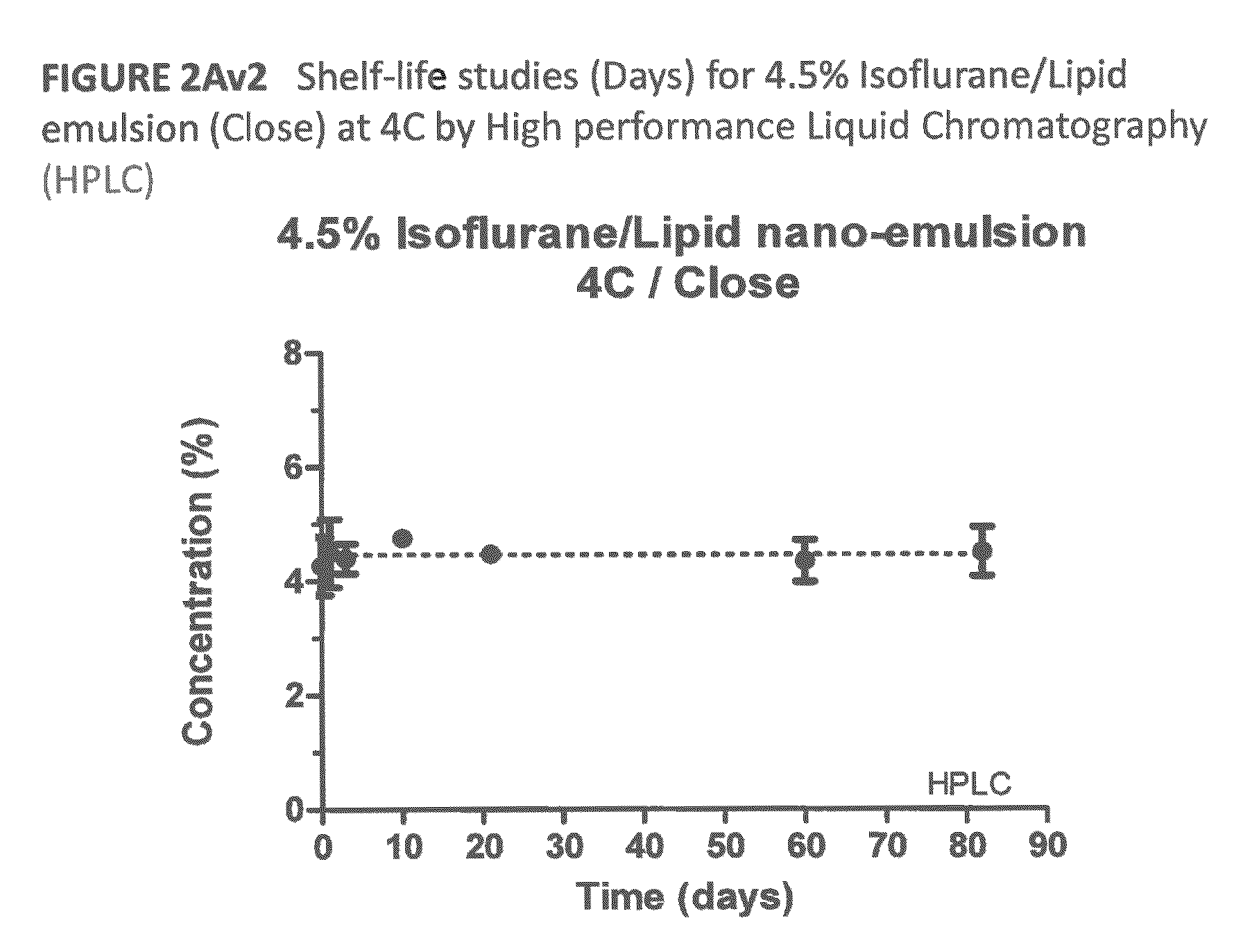Stable liquid formulations of volatile gas anesthetics
a volatile gas anesthetic and liquid formulation technology, which is applied in the direction of salicyclic acid active ingredients, organic non-active ingredients, oil/fat/waxes non-active ingredients, etc., can solve the problems of unpleasant inhalation of volatile gas anesthetics, irritating the patient's airway, and requiring expensive and specialized equipment and instruments
- Summary
- Abstract
- Description
- Claims
- Application Information
AI Technical Summary
Benefits of technology
Problems solved by technology
Method used
Image
Examples
example i
Preparation of Stable Liquid Formulations of Volatile Gas Anesthetics
A. Formulation of a 4.5% Isoflurane / INTRALIPID® Based Emulsion.
[0117]Reagents.[0118]1. LUTROL® F68NF[0119]BASF Corp., Florham Park, N.J.[0120]2. 30% INTRALIPID® (specific gravity=0.91)[0121]Baxter Healthcare, Deerfield, Ill.[0122]3. Phosphate buffer solution (“PBS”)[0123]e.g., Invitrogen Corp., Carlsbad, Calif.[0124]4. Isoflurane (clinical grade)
[0125]Equipment.[0126]1. 1 L beaker[0127]2. 500 mL filter flask[0128]3. 50 cc conical tube[0129]4. Ice and bucket[0130]5. Temperature controlled water bath[0131]6. Vortexer[0132]e.g., Vortex Mixer, VWR Int'l., Radnor, Pa.[0133]7. Water bath sonicator—Model F550 Sonic Dismembrator Fisher Scientific, Springfield, N.J.
[0134]Preparation.
[0135]A surfactant solution is initially prepared by weighing out 200 grams (“g”) of LUTROL® F68NF, a block polymer having a central, hydrophobic block comprising a polypropylene oxide attached between two hydrophilic blocks of polyethylene oxid...
example ii
Measurement of Volatile Gas Anesthetic Concentration in a Stable Liquid Formulation
[0183]In order to assess the stability of the liquid formulations of volatile gas anesthetics prepared in accordance with the procedures presented above in Example I, several methods were developed to permit the measurement of the concentration of a volatile gas anesthetic present in a liquid solution, such as an emulsion or nanoemulsion.
A. Volatile Gas Anesthetic Concentration Measurement by HPLC.
[0184]The method was utilized to measure the concentration of volatile gas anesthetic in each of the nanoemulsions prepared in accordance with the procedures presented above in an Examples I-A and I-B via high performance liquid chromatography (“HPLC”) utilizing a LaChrom Elite system, as manufactured by Hitachi High Technologies America Corporation of Schaumburg, Ill. More in particular, the concentration of volatile gas anesthetic in the aforementioned nanoemulsions was measured under various storage condi...
example iii
Stability of Liquid Formulations of Volatile Gas Anesthetics
A. Concentration of Volatile Gas Anesthetics in Liquid Formulation as Measured by HPLC.
[0200]1. Isoflurane / INTRALIPID® Based Emulsion—Open Container.
[0201]A 4.5% isoflurane / INTRALIPID® based emulsion was prepared in accordance with the procedure presented above in Example I-A. Portions of the emulsion were stored in open containers and exposed to ambient air at temperatures of 25° C., to approximate room temperature, and 37° C., to approximate human body temperature, and periodic samples were withdrawn and analyzed in accordance with the procedure identified in Example II-A above. FIGS. 1A and 1B illustrate the results of these tests with isoflurane concentration, in weight percent, along the y-axis, and time, in hours, along the x-axis of each these figures.
[0202]As illustrated in FIG. 1A, the portion of the 4.5% isoflurane / INTRALIPID® based emulsion retained about 93% of its original concentration of isoflurane while stor...
PUM
| Property | Measurement | Unit |
|---|---|---|
| size | aaaaa | aaaaa |
| body temperature | aaaaa | aaaaa |
| body temperature | aaaaa | aaaaa |
Abstract
Description
Claims
Application Information
 Login to View More
Login to View More - R&D
- Intellectual Property
- Life Sciences
- Materials
- Tech Scout
- Unparalleled Data Quality
- Higher Quality Content
- 60% Fewer Hallucinations
Browse by: Latest US Patents, China's latest patents, Technical Efficacy Thesaurus, Application Domain, Technology Topic, Popular Technical Reports.
© 2025 PatSnap. All rights reserved.Legal|Privacy policy|Modern Slavery Act Transparency Statement|Sitemap|About US| Contact US: help@patsnap.com



